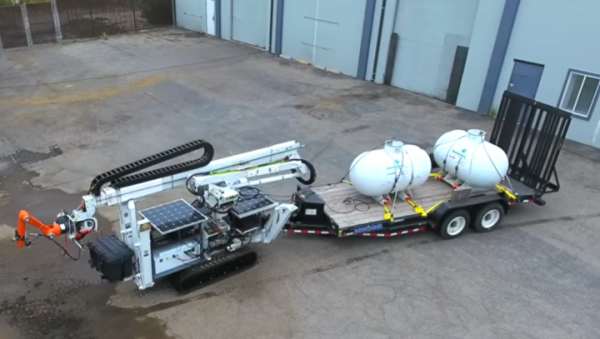By Ribhu ., | April 30, 2017

The Digital Construction Platform has a vehicle carrying a large, industrial robotic arm that has a smaller, precision-motion robotic arm at its end. (YouTube)
A group of researchers from the Massachusetts Institute of Technology (MIT) has built a framework that is equipped to 3-D print the essential structure of a whole building.
The new structure, named Digital Construction Platform (DCP), was described in a paper published in the journal Science Robotics. It could deliver structures in a fast and less expensive than conventional development techniques.
Like Us on Facebook
"The construction industry is still mostly doing things the way it has for hundreds of years," said Steven Keating, a mechanical engineering graduate at MIT and lead developer of the system, in a press release. "The buildings are rectilinear, mostly built from single materials, put together with saws and nails."
The Digital Construction Platform comprises of a vehicle conveying a huge, mechanical automated arm that has a smaller, accuracy movement automated arm at its end. The smaller arm is controlled to be used to coordinate any customary development spout, including those used for pouring cement and materials.
To try out the new 3-D printing framework, the scientists built up a model that could be used to shape a completed solid structure. Unlike traditional 3-D printing, the Digital Construction Platform is a free-moving framework that can develop a shape of any size and is not just constrained to building objects that can fit in their area. Moreover, MIT's new 3-D printing framework has an extension equipped for making building surface and gathering materials.
Like the commercial cement formwork systems, the development strategy used by the scientists involves filling the polyurethane molds with cement. Their model took under 14 hours of printing time to manufacture the essential structure of the dividers of 50-foot-measurement, 12-foot-high vault.
An ultimate vision of the Digital Construction Platform is to have something autonomous that can be sent to distant spots, for example, Antarctica, or even Mars, to make structures that can for a considerable length of time. For this reason, the scientists built up the new framework which runs on solar power.
-
Use of Coronavirus Pandemic Drones Raises Privacy Concerns: Drones Spread Fear, Local Officials Say

-
Coronavirus Hampers The Delivery Of Lockheed Martin F-35 Stealth Fighters For 2020

-
Instagram Speeds Up Plans to Add Account Memorialization Feature Due to COVID-19 Deaths

-
NASA: Perseverance Plans to Bring 'Mars Rock' to Earth in 2031

-
600 Dead And 3,000 In The Hospital as Iranians Believed Drinking High-Concentrations of Alcohol Can Cure The Coronavirus

-
600 Dead And 3,000 In The Hospital as Iranians Believed Drinking High-Concentrations of Alcohol Can Cure The Coronavirus

-
COVID-19: Doctors, Nurses Use Virtual Reality to Learn New Skills in Treating Coronavirus Patients







